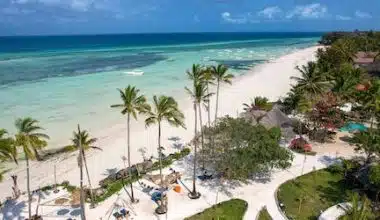The Himba tribe, located in southern Africa, is well-known for its crimson ladies. Namibia’s northwest has long been a popular destination for tourists, particularly photographers, lured by the Himba people. The Himba tribe gained international recognition for their distinctive way of life, red skin, and dreadlocked hair after incredible photos were published. We’ll learn more about the red women of the Himba tribe in this blog post.
Himba Tribe Women
The fascinating topic of the Himba women’s tribe is gaining international attention due to their refusal to adopt modern practices and adhere to antiquated customs.
They continue to be subjected to an odd “guest culture” because of their tradition, even if things have changed in the twenty-first century. More specifically, married women serve complimentary bedroom services to guests arriving at this tribe.
The Himba culture has always insisted on and practiced this. Even the northern climate shifts, which many consider to be regressive, cannot eradicate this practice. But the bad that the culture has brought with it is not going to go away anytime soon.
This minority group lives in the northern region of Namibia. The Ovahimba and Ovazimba people, who live in Omusati and Kunene in northern Namibia, are tiny sub-tribes of the tribe.
Who are the Himba women?
This culture is fascinating since it accords tremendous honor to guests by providing free coitus from women of the Himba tribe. The idea that it is a gift to the locals justifies this custom.
When a guest arrives, an often polygamous husband gives his wife a warm bed. The treatment is referred to as “Okujepisa Omukazendu.” The husband sleeps in a separate room when he ‘lends out’ his wife to a guest, as custom dictates.
When the house is small, the wife “welcomes their guest” while he spends the night outside gazing at the stars.
According to the tribe, this culture is passed down from one generation to the next to promote solidarity and stifle envy within the group.
Men are the ones who decide what is good and bad. In such practices, patriarchal society has not given women of the Himba tribe much voice. They must do as the tradition commands, asking no questions at all.
Sometimes, women won’t let guests stay the night in their homes. She will have to sleep in the guest’s room while her husband sleeps in a separate room if she declines this offer, but there are no consequences for her actions.
When one of her acquaintances visits her farm, she is also obliged to share her spouse with them, but this doesn’t happen very often. Men have as many offspring as their homesteads can support by marrying multiple women.
How do Himba People Shower?
The fact that women of the Himba tribe are prohibited from using water for washing is one of their most notable characteristics. This refers to both them and their attire. Once more, the elderly claim that this is related to the great droughts when water was scarce and only males were permitted to use it for washing. Himba women take a daily smoke bath in addition to applying red ochre to their skin as a kind of personal cleanliness.
They will wait for the smoke to ascend after placing some burning charcoal into a small basin filled with herbs, primarily leaves and small branches of Commiphora trees. Then they will bow over the smoking bowl, and they will begin to perspire because of the heat. They drape a blanket over themselves when doing a complete body wash to trap smoke beneath the material.
The Himba people crossed the border into Angola in the early 16th century and settled in Kaokoland, which is today known as the Kunene region, as their new homeland. Since they had not yet broken away from the Herero tribe, the term “Himba” did not exist at that time.
The end of the 1800s brought a persistent bovine outbreak to Namibia. The majority of the Herero’s cattle died, leaving the tribe in a dire situation. The tribe then headed south and began to explore new areas to increase their chances of surviving. However, other members decided to remain and fight for survival in known areas. The Himba identity emerged as the division between the two tribes materialized at that point.
Himba Women’s Red-Ochre-Tinged Appearance
The application of otjize, a concoction of ochre, butterfat, and other materials, to the skin by Himba tribe women is one of the most characteristic features of Himba culture.
Their remarkable look serves multiple utilitarian uses in their harsh desert environment, making it more than just an aesthetic feature. They consider this custom to be fundamental to their cultural identity. It protects their skin from the sun, keeps mosquitoes away, and encourages good hygiene, among other things.
By hydrating the skin and hair, butterfat helps to maintain general hygiene and prevent dryness. In Himba culture, this mixture also symbolizes a bond with the soil and ancestors’ spirits.
Many Himba people in Namibia still accept this custom as an essential part of their distinct cultural legacy, despite attempts at modernization.
Himba Tribe Hairstyles
Intricate hairstyles that frequently feature jewelry and other decorative accents are another characteristic of the Himba. In addition to being aesthetically pleasing, Himba hairstyles also have significant cultural importance.
They express an individual’s age, social standing, and stage of life. Since hair is seen as an extension of the self, it is common to decorate it with beads, shells, and other ornaments to mark significant life events like marriage or childbirth.
For instance, until they reach adolescence, young ladies will style their hair in two braids using shells. After that, they’ll switch to a single braid that’s jeweled. Married women accessorize their hair with elaborate hairstyles that feature cowrie shells and carefully braided motifs.
Women of the Himba tribe usually use a mixture of ochre, animal fat, and other materials to braid their hair into elaborate styles. They frequently accessorize their heads with pearls, other trinkets, and animal pelts.
Although most men wear their hair short, others could have a little tuft of hair on top of their heads. The Himba use their haircuts as a means of communication with their ancestors and cultural legacy, much like they do with the ochre pigment applied to their skin.
Interesting Facts About The Himba Women’s Tribe
The Himba tribe is well-known for its rich cultural legacy and traditional way of life. They are found in Namibia’s Kunene area. The position and traditions of Himba women are among the many fascinating characteristics of the Himba people.
The unique appearance of Himba women is well known. They cover their bodies with otjize, a red-ochre paste derived from ochre and butterfat. Otjize is applied as a sunscreen, moisturizer, and bug deterrent. Additionally, it gives the woman’s complexion a recognizable orange-red shine.
Let’s explore some amazing details about Himba ladies and the distinctive customs that have helped to maintain their culture for many years.
#1. Accessories and Otjize
The Himba tribe’s ladies are renowned for having remarkable looks. They cover their bodies with otjize, a red-ochre paste derived from ochre and butterfat. Their skin takes on a characteristic reddish-orange color from this mixture, which also serves as a moisturizer, sunscreen, and insect repellent. The Himba women also dress in elaborate jewelry and hairstyles, such as bracelets, earrings, and necklaces made of beads and shells.
#2. Matrilineal Society and Women’s Role
The Himba people have a matrilineal society in which inheritance and property are passed down via female ancestors. Women are important members of the community because they handle everyday responsibilities like childrearing, cooking, and cleaning. Their support is vital to the proper operation of Himba homes and the maintenance of traditional customs.
#3. Skilled in Traditional Crafts
Himba women are exceptionally talented at traditional crafts like pottery and basket weaving. Their artistic expression and strong ties to their cultural heritage are evident in their craftsmanship. In addition to being useful, these elaborate works of art have cultural and symbolic value for the Himba people.
#4. Spiritual Significance
The Himba women play a crucial part in the tribe’s spirituality. They take part in ceremonies, rituals, and customs, guaranteeing the survival of ancestors’ customs and spiritual beliefs. Their participation and spiritual leadership support the harmony and welfare of the Himba people.
#5. Hospitality and Sense of Community
Himba women are renowned for their friendly smiles and gracious hospitality. They are skilled at creating a welcoming and inclusive atmosphere and exemplify a great sense of community. Visitors to Namibia should take advantage of the Himba people’s hospitality because it offers a unique perspective on their way of life.
Key Beliefs And Rituals Of The Himba Tribe
Ancestor worship is one of the core beliefs of the Himba tribe. The Himba people have the belief that their ancestors continue to have a significant impact on their lives and can be reached through rituals and offerings.
The Himba celebrate their ancestors with unique rituals, like the Epupa festival, in which they dance and chant in remembrance of their forefathers.
In addition, the Himba perform rainmaking rituals in response to natural disasters like droughts. Prayers, dances, and animal sacrifices are all part of these rites, which are intended to placate the spirits and bring rain for agricultural growth.
Their distinct cultural identity is reflected in these behaviors and beliefs, which are fundamental to their way of life.
Himba Tribe Religion
The OvaHimba are a monotheistic people who venerate their ancestors (ancestor reverence) and the god Mukuru. The ancestors can both bless and curse, but Mukuru only grants blessings. The firekeeper tends to the sacred ancestral fire that belongs to each family. Every seven to eight days, the fire-keeper goes to the hallowed ancestral fire to speak with Mukuru and the ancestors on his family’s behalf. Because Mukuru is active in a different domain, his ancestors frequently represent him.
The term “black magic” or “bad medicine” refers to omiti, which some OvaHimba translates as witchcraft. To be precise, some OvaHimba think that omiti—or rather, omiti used maliciously—causes death. Furthermore, some people think that evil people who utilize omiti can scan into the minds of others or bring about extraordinary events (such as a common illness turning deadly). However, omiti users don’t always go straight for their victim—occasionally, they target a loved one or relative. Some OvaHimba will seek the advice of a traditional African diviner-healer to learn the cause of the omiti or the explanation behind an unusual event.
What Do the Women Do in the Himba?
For all young Himba women, learning how to braid and texture their hair the traditional way is a must. Because they are expected to trek to the closest water source, girls have a significant role in the family structure. They are barely out of high school and are tasked with looking after the animals.
Which Tribe Offers Wife to Guest?
The African tribe known as the Himba offers their guests a wife.
What Age Do They Marry in the Himba Tribe?
Early-arranged marriages are customary there. Himba females of a younger age marry men selected by their dad. This occurs starting with puberty, which could lead to the marriage of girls who are 10 years old or younger.
What Does the Himba Eat?
The Himba typically consume gruel made from cornflowers; they only eat meat once every two weeks, such as springbok, goat, and beef.
What Is the Most Beautiful African Tribe?
Some claim that the Himba are the most attractive tribe in Africa. Their otjize-coated hair and skin give them a flawless, luminous complexion, and their thin build and upright posture give them an ethereal grace.
What Language Does Himba Speak?
The Bantu language, known as OtjiHimba, is mainly spoken in the Kunene region of Namibia and some areas of Angola. Because it is a tonal language, the pitch or tone at which a word is spoken can alter its meaning.
Can Anyone Visit the Himba tribe?
There are numerous ways to plan a visit to a community since Himba tribe tourism is increasingly popular in Namibia. A Himba tribe tour is something that almost all guesthouses in the area offer, although they can be highly commercial and even a little contrived.
Summary
Namibia’s Himba women are essential to maintaining their community, culture, and legacy. They are incredibly fascinating because of their unique look, cultural customs, and contributions to the tribe. We have a greater understanding of the diversity and tenacity of African tribal cultures by studying the Himba women. Visit the Himba people of Namibia if you ever get the chance to see their fascinating customs and feel their friendly welcome.
- SAN PEOPLE OF AFRICA: History & Rich Cultural Heritage
- IS MOROCCO SAFE FOR AMERICANS?
- AFRICAN SAFARI TRIPS: Unforgettable Encounters in the Heart of Africa
- BEST PLACES TO VISIT IN AFRICA: Exploring the Continent’s Less Traveled Treasures






